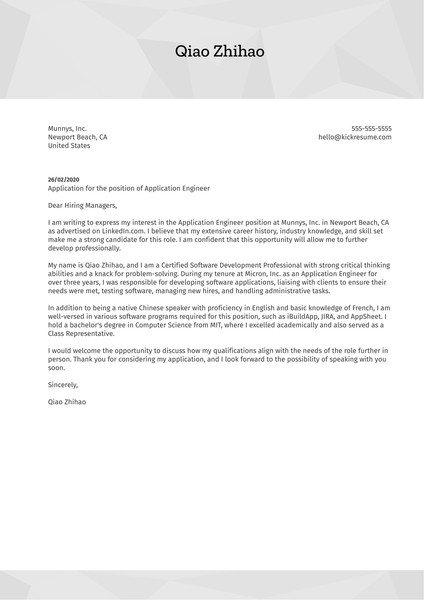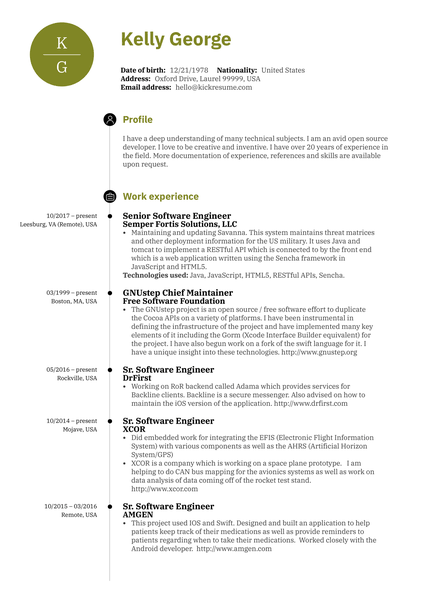How to craft a professional tester cover letter
Professional testers fulfill a variety of roles, including testing out new software products such as professional platforms, video games, and more. To become a tester, you must write an optimized cover letter that showcases your best qualifications and professionalism in the position.
In this guide, we discuss the key components that make up a great tester cover letter. Keep reading to learn all about:
- Creating a tester cover letter header and headline
- The crucial importance of personalizing your tester cover letter
- Key details to include in your tester cover letter introduction
- Ways you can effectively describe your qualifications as a tester
- Why persuading an employer to contact you in your conclusion is essential
1. Create an effective tester cover letter header and headline
As a tester, one of your core responsibilities is to have excellent attention to detail.
The best way to showcase this immediately is by creating a visually appealing cover letter header and headline. By doing so, you show the employer that you understand the importance of not just quality content but also excellent presentation.
Your cover letter header is the first element to focus on crafting. It should be placed at the very top of the page, either center- or left-aligned. In it, you should list your name, professional title, and professional contact information.
Additionally, you should also list the employer’s company name and mailing address.
Here is an example of a well-formatted tester header
Samuel Tyrell, Professional Software Tester
(123) 456-7890 | samtyrell@email.com | linkedin.com/in/sam-tyrell
To: Moist Games, Inc.
Testing Department
1234 Street Address
Denver, CO 80014
After creating your header, your next task is to write a compelling cover letter headline.
A headline is like a title to a book, meant to introduce the main concept and hook the attention of the reader. In a headline, you should always include a keyword related to the position, an eye-catching number or trigger word, and a powerful adjective or verb.
You should also include a detail or statement that makes the headline personalized to the employer.
Here is an example of a great headline from a tester cover letter
My 3-Step Approach to Effective Software Testing & How It Can Benefit Your Company’s Games
2. Personalize your tester cover letter with a proper greeting
Employers have to read through many cover letters every time they go through the hiring process. The letters that are extremely generic and sound like they could be addressed to anyone often end up in the trash, while the personalized ones move on to the next stage of the hiring process.
Thus, you should always personalize your cover letter with details that are highly specific and relevant to each employer you reach out to.
In addition, you should also include a personalized greeting on your cover letter that addresses a specific person by name, such as a business owner or hiring manager.
Here are 3 examples of personalized tester cover letter greetings
- Dear Lead Producer Mack Smith,
- Dear Mr. Mack Smith,
- Dear Hiring Manager Jack King,
3. Key details to include in your tester cover letter introduction
A well-written introduction is a highly important element in any cover letter, as it further helps to hook the employer’s attention and make them interested in what you have to say.
To write an excellent introduction, try to include the following details:
- A brief overview of your professional history and goals
- A statement on why you are enthusiastic about applying to this company
- Any specializations you possess as a tester
Here is an example of a well-written tester cover letter introduction
Dear Hiring Manager Jack King,
As a professional software tester, I have worked for 7 years in the video and mobile game industry. I hold three certifications in game testing, as well as numerous awards for my achievements in the field. I have long been inspired by your company’s innovation in the industry and am beyond excited to write to you today for consideration for this opportunity to join your growing team of testers.
4. Effectively describe your qualifications in a tester cover letter
Following your introduction, you can now begin to describe each of the key qualifications that make you the perfect professional for the role of a tester.
In describing your skills, accomplishments, and other qualifications, you should remember the research you completed to personalize your letter and sprinkle that information in whenever possible. Additionally, remember to keep your descriptions concise and specific — the employer should be able to easily skim through your letter to gather than key points you make.
Here are 6 skills to describe in a tester cover letter
- Quality assurance
- Problem analysis
- Troubleshooting
- Writing test reports
- Strong written and verbal communication
- Software risk mitigation
Here is an example of how to describe an accomplishment in a cover letter
As a software tester at [Former Employer], I served as the final tester before a product was sent to post-production and distribution. By implementing a new system for software analysis, I was able to reduce final errors by 30% and reduce human testing errors by more than 65%.
5. Craft a persuasive tester cover letter conclusion
In the conclusion to your tester cover letter, your primary goal is to persuade the employer to contact you.
Not only do you want to convince them to contact you but you want to add a sense of urgency that persuades them to contact you as promptly as possible.
To do this, you should include:
- An enthusiastic sentence saying you are looking forward to hearing from them
- The best method for contacting you, as well as when you would like to hear from them
- When you intend to follow up if you have not heard back from them
- A formal sign-off
Here is an example of a persuasive tester cover letter conclusion
As a longtime supporter of your company, it brings me great excitement to now be considered for a role in your team of testers. I hope to hear from you within the next week regarding this position and can be best reached at (123) 456-7890, any weekday from 8 a.m. to 4 p.m. If I have not heard back by next Thursday evening, I plan to follow up via email at that time.
Sincerely,
[Applicant Name]
If you have ever wondered how a cover letter differs from a resume, this article will tell you everything about the key differences between the two.
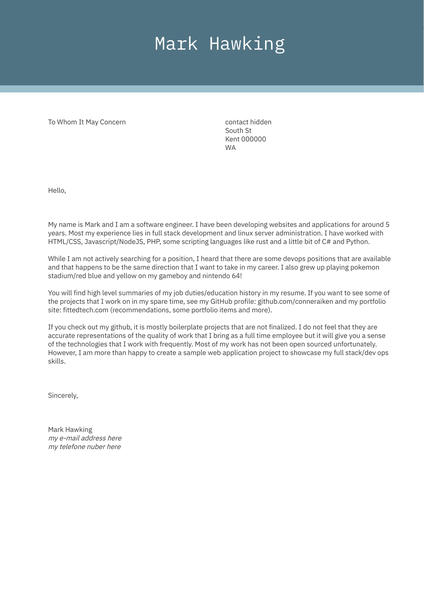




![Webmaster/webmestre Cover Letter Example [FR]](png/thumbnail-82.png)
